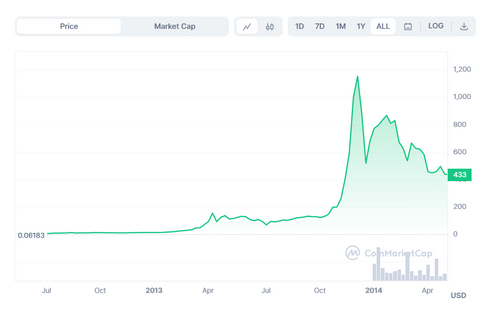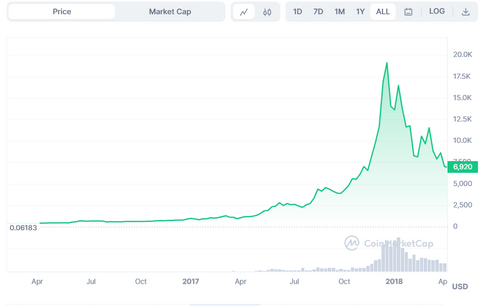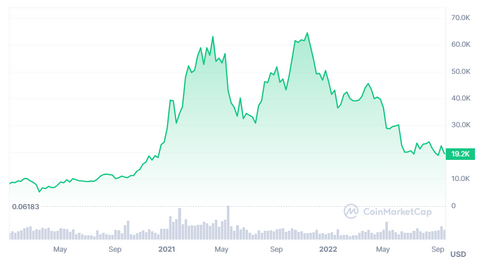Bitcoin halving dates mark key milestones in the BTC calendar and lifestyle. For Bitcoin purists, the halving represents a foundational element of BTC’s intrinsic value. For traders, the halving suggests that positive price action might be on the horizon.
As the digital clock ticks towards predetermined dates, the crypto community buzzes with anticipation, speculating on the ripple effects of each Halving on Bitcoin's price.
What underpins this cyclical event, and how has it shaped Bitcoin’s price history?
What is the Bitcoin Halving?
Ever wondered why crypto bull runs seem to rise and fall like clockwork every 4-5 years? If you’ve followed the cryptocurrency space for some time, you’ll notice that every cycle starts with a surge in Bitcoin price action. This generally stems from the Bitcoin halving.
Written directly into Bitcoin’s code, the Bitcoin Halving is a programmed reduction in the amount of BTC rewards miners receive for validating transactions and adding new blocks to the blockchain.
Envisioned by the enigmatic Satoshi Nakamoto, this event occurs approximately every 210,000 blocks, translating to roughly four years. The Halving is Bitcoin’s answer to controlling inflation, a stark contrast to the fiat world’s approach.
By halving the rewards, the rate at which new bitcoins are introduced into circulation slows down. This reduction has two main effects on Bitcoin’s market dynamics.
Firstly, BTC sell pressure from miners is essentially cut in half, reducing negative price impacts. Secondly, circulating Bitcoin becomes more scarce, due to the amount of Bitcoin entering the market is diminished.
These factors combined have historically proved a boon for Bitcoin price action, which has consistently seen positive returns in the years following a Bitcoin halving.
Bitcoin Halving Price History
Since the birth of the Bitcoin economy, each halving has signaled the arrival of a new cryptocurrency bull market.
Let's recap Bitcoin's price history and explore the aftermath of each halving and the ensuing impact on the cryptocurrency's price.
First Halving - November 28, 2012
In November 2012, the Bitcoin community found itself on the cusp of a historic milestone—the first-ever Bitcoin Halving. Given it was the first time a halving had ever happened, Bitcoin enthusiasts were curious to see if block rewards would actually diminish as promised.
At this point in time, Bitcoin, blockchain, and cryptocurrency as a whole was still in its infancy. Would it all turn out to be a big scam like so many nay-sayers had predicted?
In the lead-up to the first halving, BTC traded hands around $12. As the fateful block was reached, BTC miner rewards dropped from 50BTC per block to 25 BTC per block as promised.

Over the course of the next year, Bitcoin’s value skyrocketed, breaking the $1,000 barrier and marking a new all-time high of $1,152 in December 2013, just one year after the first halving.
The first halving was something of a revelation. It showed that Bitcoin’s emission schedule was working correctly and that the asset served its anti-inflationary design.
Second Halving - July 9, 2016
Fast forward to July 9, 2016, the crypto sphere once again found itself at the doorstep of the next great milestone. This time, people were more prepared. The halving had functioned correctly before, surely it would work again?
It’s worth noting that the second Bitcoin halving unfolded against a backdrop of increased awareness and acceptance of Bitcoin. The digital currency was still widely stigmatized by the public and the media, but it was becoming more commonplace.
Bitcoin was valued at approximately $650 at the time of the second halving having suffered brutal price drops in the previous years. The block reward, once 25 BTC following the first halving, faced another reduction, this time dropping to 12.5 BTC.

Again, the scarce supply and reduced sell pressure breathed new life into Bitcoin. The world’s largest digital currency surged from strength to strength over the next year, finally topping out at around $20,000 in December 2017.
If the first halving was a revelation, the second was a reaffirmation. Bitcoin’s potential as a store of value was undisputable, fueling discussions and speculations about the future of this digital asset.
Third Halving - May 11, 2020
Like clockwork, the third Bitcoin halving rolled around after another 210,000 blocks. The calendar marked May 11, 2020, and the crypto community was abuzz with anticipation.
By this time, traders had begun to see a pattern. Eager investors were buying BTC well ahead of the halving in anticipation of an upcoming bull run.
As forecast, Bitcoin mining rewards dropped yet again, this time from 12.5 BTC per block to just 6.25.
The third Bitcoin halving was special. The COVID-19 pandemic was putting enormous pressure on the global economy and inflation statistics were hitting unprecedented levels. Bitcoin, often dubbed "digital gold," was under the microscope, with enthusiasts and skeptics alike eager to see what would unfold.

Bitcoin, trading around $8,787 during the halving, pushed further than it ever had before. The digital currency reached new heights, achieving an all-time high of nearly $69,000 in November 2021.
When is the Next Bitcoin Halving?
The next halving will once again alter the landscape of Bitcoin mining rewards. As expected, Bitcoin’s reward of 6.25 BTC, will be cut in two and dwindle to 3.125 BTC. This adjustment will further amplify Bitcoin’s scarcity, potentially setting the stage for another chapter of value appreciation.
According to forecasts, we expect the upcoming Bitcoin halving to occur around the 25th April, 2024.
Is BTC Guaranteed to Rise After Every Halving?
As we approach the next Bitcoin halving, the air will undoubtedly be charged with speculation and anticipation. Every previous halving has resulted in huge returns for Bitcoin investors, surely the next halving will be no different?
Well, there’s no way of knowing for sure. The crypto market has a habit of humbling people who think that something is guaranteed to happen. What’s more, every crypto bull cycle born from a halving has produced diminishing returns.
For example, look at approximate BTC prices from the date of the halving to the peak of the cycle.
- First halving: $12 - $1152 (9500% increase)
- Second halving: $650 - $20,000 (2976% increase)
- Third halving: $8787 - $68,700 (681% increase)
In each consequent cycle, Bitcoin price appreciation is significantly less than the previous cycle. Given that Bitcoin is now more popular than it has ever been and is starting to be adopted as legal tender in some countries, it would be foolish to blindly assume that Bitcoin will rise after the next halving.
What Happens When All Bitcoin Has Been Mined?
The Bitcoin protocol, with its hard-coded cap of 21 million coins, dictates that the era of block rewards will eventually draw to a close, estimated to be in the year 2140.
In this distant future, it is theorized that network transaction fees will become the sole reward for miners’ efforts in validating and securing the network. These fees, paid by users for transaction processing will become the lifeblood of the Bitcoin ecosystem, sustaining the network’s security.
The transition to a fee-only model raises intriguing questions about the dynamics of the Bitcoin network. Will transaction fees be enough to incentivize miners? How will this shift impact transaction costs and network security? For now, no one has definitive answers.
Bottom Line
The Bitcoin halving is a fundamental principle that shapes how BTC is distributed to miners. While it has previously marked the beginning of upcoming crypto bull runs in the past, there is no guarantee that it will continue to do so.
It’s crucial to remember that Bitcoin is about so much more than price appreciation and asset growth. The network also champions the importance of self-custody and decentralization, giving you complete freedom and control over your digital assets.
A key part of self-custody that you should never overlook is Bitcoin security. Whether BTC is worth $1 or $1,000,000, it means nothing if you don’t take care of your BIP39 seed phrase. At CVER Steel, we provide the best possible solution for backing up your seed phrase and keeping your Bitcoin safe.
Don’t hesitate to visit our store and browse our exceptional range of Bitcoin security products.
F.A.Q.S.
Will Bitcoin go up or down after halving?
While Bitcoin has historically gone up after halving, there are no guarantees that this will always be the case. The best way to prepare for a Bitcoin halving is to educate yourself on exactly what happens during a halving.
What date is the next Bitcoin halving?
The next Bitcoin halving is expected to occur around the 25th of April, 2024.
Is Bitcoin halving good or bad?
Whether the Bitcoin halving is good or bad depends on your point of view. For example, traders might say the halving is good because it brings volume and attention to the crypto markets. On the other hand, miners might say it’s bad because they earn less mining rewards than they would previously.

